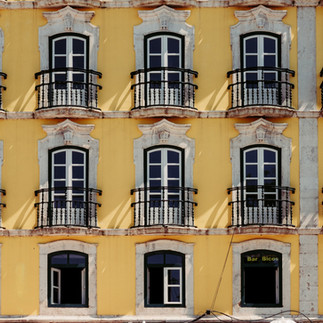Lisbon Sardine Festival 2025: Best Guide for June
- Pedro Ferreira
- Sep 28, 2024
- 8 min read
Updated: Mar 2

The Santo Antonio Festival in Lisbon is one of Portugal’s most renowned annual street celebrations, held every year in early June and drawing thousands of visitors to the capital.
WHEN: Thursday, June 12th to Sunday to June 15th, 2025 – with the main festival day falling on Friday, June 13th, 2025.
As Lisbon’s most significant festival, the Santo Antonio Festival honors Saint Anthony, the city’s patron saint, who is also known as the protector of marriages and lost items. Originally called the "Festas dos Santos Populares" (Feasts of the Popular Saints), the celebration has evolved into a grand street party that showcases the city’s culture rather than its religious roots.
A Brief History of the Lisbon Sardine Festival
The origins of the Lisbon Sardine Festival are deeply rooted in the city’s religious and cultural traditions. It began as part of the broader "Festas de Lisboa," a series of June festivities honoring various saints. Saint Anthony, the city’s patron saint and known as the "matchmaker saint," is especially revered during these celebrations.
What started as a modest neighborhood gathering has, over the decades, evolved into a citywide spectacle. By the mid-20th century, the festival had become a staple of Lisbon’s cultural calendar, with local councils and community groups organizing larger events that featured music, dancing, and parades. The enduring appeal of the festival comes from its combination of religious devotion, culinary tradition, and community spirit, making it a unique and much-loved event in Lisbon.
Basil & Sardines The festivities begin early in the afternoon, with street vendors serving grilled sardines, and traditional folk music echoing through the lively, colorful streets. The festival is particularly popular with newlyweds or singles in search of romance! A traditional way to boost your romantic luck is by gifting or receiving a pot of basil, which can be bought near the Santo Antonio Church in the Alfama district.
Stay in Alfama: Alfama, one of Lisbon’s oldest neighborhoods, offers a charming atmosphere with its narrow streets lined with shops selling traditional crafts and cozy cafés. A ride on the iconic No. 28 tram, which passes through Alfama on its route to the 11th-century São Jorge Castle, is a must-do. For a comfortable stay, consider the Santiago de Alfama Boutique Hotel, known for its breathtaking views and highly rated breakfast options, earning a “Superb” rating from guests.
The Main Parade The highlight of the Santo Antonio Festival is the vibrant main parade, where locals don stunning and elaborate costumes as they march along Avenida da Liberdade. This dazzling display rivals the famous Rio Carnival in its energy and spectacle. For the best parade views, head to the historic streets of Alfama, Bica, Bairro Alto, Castelo, and Madragoa, where the celebrations are at their liveliest.
The Lisbon Sardine Festival is a lively and vibrant celebration that transforms the streets of the Portuguese capital into a hub of energy and excitement.
A Celebration of Sardines and Community During the festival, the mouthwatering aroma of grilled sardines fills the air as locals and visitors alike gather to partake in this cherished tradition. The streets buzz with music, dancing, and laughter, creating an atmosphere of pure joy. Brightly decorated streets and vibrant costumes further enhance the festive spirit, making it one of Lisbon’s most anticipated annual events.
Why Lisbon Celebrates the Sardine Festival The festival honors the sardine, a key part of Portuguese cuisine, especially beloved by the working class. Sardines have long been a symbol of Lisbon’s deep maritime culture. The festival is more than just a culinary celebration—it’s a testament to the city’s sense of community, bringing people from all walks of life together to celebrate unity, tradition, and shared happiness. The event highlights Lisbon’s rich cultural identity, making it a day of pride and celebration for all who attend.
What It’s Like in Lisbon on June 12
On the evening of June 12, the celebrations in Lisbon truly come to life after sunset. Around 9 PM, head to Avenida da Liberdade for the Marchas Populares parade (details below), then make your way to one of the festive neighborhoods for a night filled with chaotic fun, drinking, and dancing.
If large crowds aren’t your thing, especially in the post-pandemic world, consider yourself warned. My first Santo António Festival was in Alfama, and I've never been in a more packed crowd. At one point, while holding hands with friends to avoid getting separated, I was literally carried by the crowd for several meters without my feet touching the ground.
Known as Lisbon’s longest night, the party goes on until dawn. Taxis are hard to come by, so walking home is usually your best option. The next day is a public holiday—likely because the city needs to recover from the festivities!
Where to Stay for the Festivals
Top Hotels Near Rua Augusta, Praça do Comércio, and Belém
Lisbon’s hotel scene is a vibrant mix of luxury, charm, and budget-friendly gems, perfect for any traveler hitting the city in 2025. These standout hotels offer something special. Here’s where to rest your head in style.
Memmo Alfama: Tucked in Alfama’s historic alleys, this boutique hotel is steps from São Jorge Castle and the Sé Cathedral. It’s easily walkable from downtown trams, with a mid-range price of around $200–$250 per night for sleek, modern double rooms or suites with river views. The rooftop terrace adds a chic touch to this intimate stay.
Tivoli Avenida Liberdade Lisboa: On the elegant Avenida da Liberdade, this 5-star icon is close to Chiado and Bairro Alto, with metro stops nearby. Prices hover at $250–$350 per night for luxurious doubles, twins, or suites with city views and marble bathrooms. The rooftop bar seals the deal for a glamorous stay.
Hotel Santa Justa: Steps from Rua Augusta and Praça do Comércio in Baixa, this boutique hotel is surrounded by trams and metro stops for easy Belém access. Prices range from $150–$200 per night for modern doubles or suites with city views. It’s a stylish mid-range pick with a prime downtown perch.
Vincci Baixa: A block from Praça do Comércio and Rua Augusta, this chic hotel offers a short tram ride to Belém and walkable metro connections. Expect $120–$170 per night for sleek doubles or twins, some with balconies overlooking the bustle. Its trendy vibe suits explorers who love being central.
Altis Belém Hotel & Spa: Perched in Belém near the Jerónimos Monastery and Belém Tower, it’s a tram or taxi ride from Rua Augusta and Praça do Comércio. This luxury gem costs $250–$320 per night for spacious doubles or suites with riverfront views. The spa and rooftop pool elevate your stay.
Hotel Riverside Alfama: Close to Praça do Comércio and a short stroll from Rua Augusta, this budget-friendly spot connects to Belém via riverside trams. Prices hover at $80–$120 per night for cozy doubles or triples with simple charm. It’s perfect for travelers prioritizing proximity on a budget.
Top Hostels in Lisbon: Budget Vibes for 2025
For backpackers or social souls hitting Lisbon in 2025, these hostels deliver affordability, community, and prime locations.
Yes! Lisbon Hostel: In Baixa’s buzzing core, steps from Rua Augusta and the riverfront, it’s perfectly linked by metro and trams. At $35–$45 per night, you get 6- or 8-bed mixed dorms (female-only options too) with curtains for privacy. The lively bar and free tours amp up the fun.
Goodmorning Solo Traveller Hostel: Located by Restauradores Square, it’s near Chiado and Bairro Alto with easy tram access to downtown. Expect $40–$50 per night for 6-, 8-, or 10-bed mixed dorms (female-only available), plus free waffles daily. It’s a social hub for solo adventurers.
Lisbon Destination Hostel: Inside Rossio Train Station, this gem is close to Rossio Square and a train ride from Belém, with metro at your feet. Prices sit at $35–$45 per night for 6- or 8-bed mixed dorms (female-only offered), featuring a garden lounge. Its historic charm and events keep the vibe buzzing.
Where to Find the Best Arraiais (Street Parties), Especially on June 12
To enjoy the best arraial (street party), come with an open mind, comfortable shoes, cash, and a sense of humor. The cheesy pimba music playing at these parties will have the local crowd singing and dancing with unmatched enthusiasm. Most pimba songs are packed with innuendo—though kids might think the lyrics are just about parking your car in the neighbor’s garage!
If you want to learn the chorus to a few popular songs, start with the King of Pimba, Quim Barreiros. The 76-year-old performer is a must-see during June, drawing huge crowds with his giant mustache, accordion, cowboy hat, and cheeky lyrics. He's an absolute riot!
The most popular neighborhoods to experience Lisbon’s Santo António celebrations are Alfama, Castelo, Mouraria, Graça, Bica, Madragoa, and Bairro Alto. You don’t need an exact address—these parties spill from one square to the next, winding through the city’s narrow streets. You’ll find plenty of grilled sardines, dancing, and festive energy in these areas. Just follow the music or the smell of sardines to find the fun, or check TimeOut’s list of arraiais (available in Portuguese).
Where to Stay in Lisbon During the Sardine Festival
If you value your sleep, carefully choose your accommodation during the Santo António festival. Entire neighborhoods like Alfama, Bairro Alto, Madragoa, Santos, and Mouraria transform into massive party zones, so expect noise late into the night. It’s worth booking a quieter place if you want some rest during the festivities.
Must-See Attractions During the Festival
In addition to the lively street parties, there’s much more to explore in Lisbon during the Santo António festival. Take a break from the crowds and discover the city’s rich cultural and historical landmarks:
Lisbon Cathedral (Sé de Lisboa): Visit Lisbon’s oldest church, located in the heart of the Alfama district. The Lisbon Cathedral is a Romanesque structure with a history dating back to the 12th century.
São Jorge Castle (Castelo de São Jorge): Perched high on a hilltop, the São Jorge Castle offers stunning panoramic views of Lisbon. This historic castle dates back to the 11th century and is a symbol of the city’s rich past.
National Tile Museum (Museu Nacional do Azulejo): Explore one of Portugal’s most iconic art forms at the National Tile Museum. Located in a 16th-century convent, the museum showcases centuries of Portuguese azulejos (tiles).
Take a Tour on the Tagus River: Escape the busy streets and enjoy a relaxing boat tour along the Tagus River. This is a fantastic way to take in Lisbon’s iconic landmarks from a new perspective, including the Belém Tower, the Monument to the Discoveries, and the 25 de Abril Bridge
Book a Dolphin Watching Tour: For a truly unique experience, book a dolphin watching tour on the Tagus River. These guided tours allow you to see playful dolphins in their natural habitat while cruising along the river.
Cultural Activities
Attend a Pastéis de Nata Baking Class: Why not learn how to make Lisbon’s beloved pastéis de nata yourself? Join a baking class where expert chefs will teach you the art of crafting these iconic Portuguese custard tarts. It’s a fun and delicious way to bring home a taste of Lisbon and impress your friends with your newfound skills.
Take a Guided Food Tour: Explore Lisbon’s rich culinary heritage by joining a guided food tour. Taste traditional Portuguese dishes such as bacalhau, pastéis de nata, and, of course, grilled sardines. A local guide will lead you through some of the best eateries in the city.
Attend a Fado Show: Experience the soul of Lisbon by attending a Fado performance. This traditional Portuguese music, known for its melancholic tunes and heartfelt lyrics, is performed in cozy taverns throughout the city, especially in the Alfama and Bairro Alto neighborhoods.
.png)




























































































